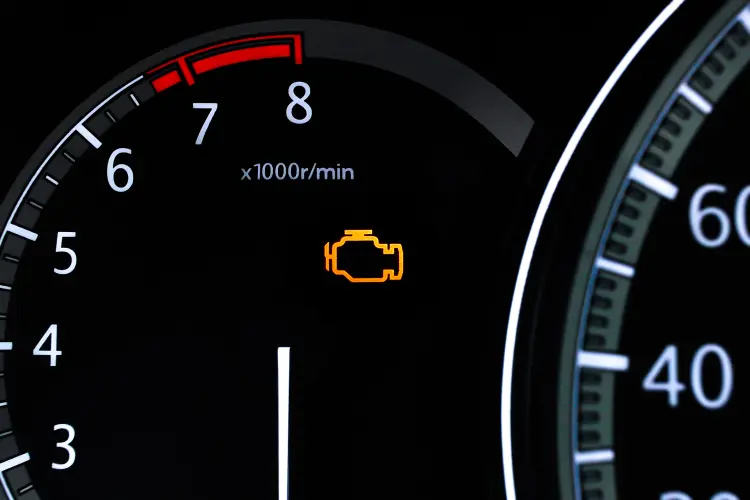What To Do When Your Check Engine Light Comes On
check engine light
5,055There’s nothing quite as unsettling as seeing that little yellow engine icon light up on your dashboard. Whether it flickers briefly or stays lit solid, your check engine light (CEL) is your vehicle’s way of telling you, “Hey, something’s not right down here!” Before panic sets in, here’s a clear, step-by-step guide for what to do next—and how an extended warranty from Cuvrd can help you avoid unexpected repair bills before your CEL lights up.

1. Don’t Panic—But Don’t Ignore It Either
A steady CEL doesn’t always mean a catastrophic failure. It could be something as simple as a loose gas cap or an oxygen sensor that needs replacing, or maybe it's extreme weather related. However, ignoring the light can allow a minor issue to become a major, costly repair.
-
Steady vs. Flashing
-
Steady Light: Indicates a non-urgent issue—safe to drive but get it checked soon.
-
Flashing Light: Signifies a serious misfire that can damage the catalytic converter; pull over safely and have it towed.
-
2. Check Basic, DIY Fixes First
Before you rush into the shop, some quick inspections at home can save you time and money:
-
Tighten or Replace the Gas Cap
- A loose, cracked, or damaged gas cap is one of the most common CEL triggers.
-
Inspect Under the Hood
- Look for disconnected hoses, obvious leaks, or frayed wiring—especially around the battery and ignition coils.
-
Check Fluid Levels
- Low oil or coolant can sometimes cause engine-management alerts. Top them off to manufacturer specs.
If the light goes off after these steps, you likely solved a small issue. If it stays on, read on.
3. Read the Diagnostic Trouble Code (DTC)
Modern vehicles store trouble codes that pinpoint the issue. You have two easy options:
-
Use an OBD-II Scanner
- Affordable handheld units (often under $50) plug into the port beneath your dash. They’ll display a code (e.g., “P0420”).
-
Visit an Auto Parts Store
Once you have the code, you can look up what it means online. Common codes often relate to oxygen sensors, catalytic converters, or ignition systems.
4. Choose a Qualified Repair Shop
Not all mechanics are created equal. Once you decide to proceed with a repair:
-
Certifications Matter
- Look for ASE-certified technicians or dealership service departments.
-
Get Multiple Quotes
- Two or three estimates can reveal big price differences. Ask each shop to break out parts vs. labor costs.
-
Warranty Approval
- If you’re using an extended warranty plan, confirm the shop is an approved provider to ensure smooth claims processing.
5. Keep Detailed Records
Whether you DIY-fixed a gas cap or completed a sensor replacement:
-
Save Invoices & Codes
- Document the trouble code, date, mileage, and repair invoice.
-
Maintenance Logs
- Note all routine service (oil changes, belt replacements, coolant flushes). Most warranties require proof of proper maintenance.
Accurate records help if a related issue pops up later—and they maximize the value of your coverage.
6. Prevent Future Check Engine Lights
After you’ve tackled the immediate issue, adopt habits to minimize surprises:
-
Follow the Manufacturer’s Maintenance Schedule
- Timely oil changes, filter swaps, and spark plug replacements keep systems humming.
-
Use Quality Parts & Fluids
- OEM or high-grade aftermarket components reduce the risk of premature failures.
-
Monitor Performance
- Strange noises, reduced power, or decreased fuel economy can signal a looming problem before the CEL ever illuminates.
6. Get Protected Before Your Check Engine Light Comes On
If your check engine light is on and your vehicle needs to be repaired, you aren't eligible for coverage. Your best defense against costly surprise repairs is to get coverage before you have problems. If you wait until your check engine light comes on, you've waited too long.
Conclusion & Next Steps
Your check engine light is a warning, not a death sentence for your drivetrain. By following these steps—basic checks, code reading, selecting a reputable repair partner, and keeping detailed records—you’ll handle the issue confidently and cost-effectively.
TL;DR: Seeing that little engine icon glow can send any driver’s heart racing, but it doesn’t have to spell disaster. In this post, you’ll learn simple at-home checks, how to decode the warning, pick the right repair shop, keep accurate records, and—best of all—lock in peace of mind beforehand with a plan from one of Cuvrd's trusted partners so a warning light never means a hefty bill.
— Neil Coker
